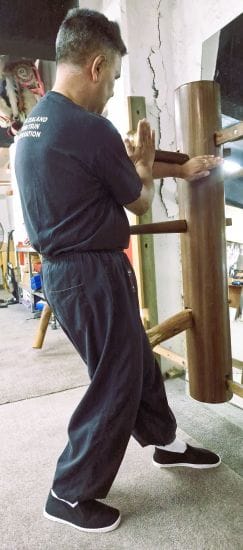
The 116 Wooden Dummy Form (木人樁 / Muk Yan Jong) is a hallmark of Wing Tsun training, combines the Siu NIm Tau, Chun Kiu and Biu Jee forms and teaches the Wing Tsun student correct hand positioning and strengthens the arms and legs. The Wooden Dummy Form is the culmination of the system’s principles applied against a structured, simulated opponent. Practicing on the wooden dummy helps a student refine technique, timing, precision, and positioning under realistic conditions.
Develop precise angles of attack and defense
Sharpen timing, distance control, and positioning
Reinforce correct structure and energy under simulated resistance
Practice footwork coordination (stepping, shifting, pivoting)
Cultivate continuous forward energy (Yee Jee Kim Yeung Ma transitions into mobile, aggressive application)
Effectively the “Wooden Dummy” is a protractor that allows a Wing Tsun practitioner to test and see how good their positioning is in the absence of a live training partner. If positioning is off and full energy is applied, the practitioner will be thrown off balance. The wooden man consists of three arms and a leg.
The wooden arms and legs can represent different things at different times. For example the ends of the arms can represent either a wrist or an elbow depending on the movement being performed. The arms themselves can have a different representation of left and right arms too depending on the movement performed.
All 116 Wooden Dummy techniques on the dummy should be performed with precision and at a steady pace.






